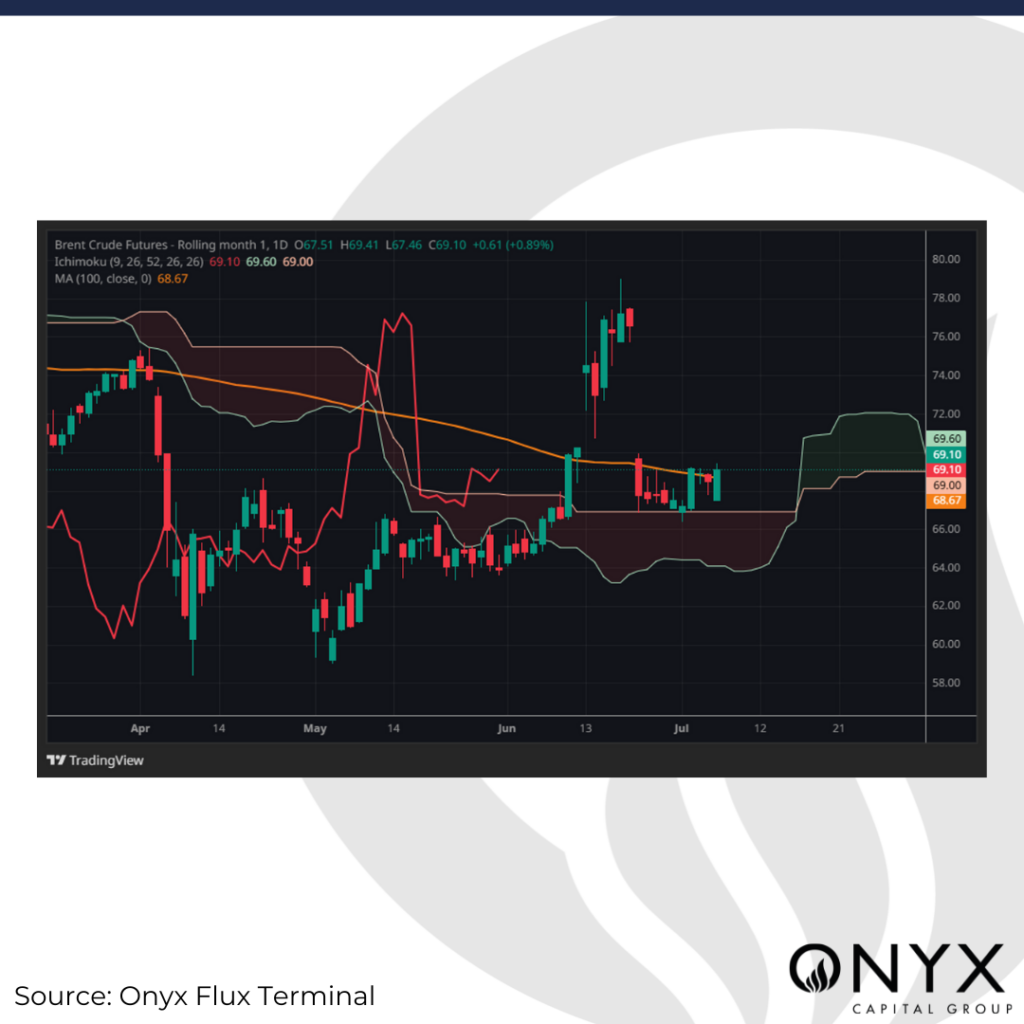Brent: troubled policy waters
Brent chalked up a 53-cent gain on the week last Friday ahead of the OPEC+ meeting held this past Saturday, 6 July, to close at $68.30/bbl. As geopolitical risk premia withdrew from prices on a lasting cease-fire between Israel and Iran, the market refocused its attention on fundamentals again. Supply and demand developments for the remainder of the year remain fraught with uncertainty. Still, Wall Street and most analysts generally see a looser global oil balance for the remainder of the year. The net length held on Brent futures by money managers fell the week ending Tuesday, 2 July, with a paring in gross long positions. In contrast, Onyx’s proprietary assessment of CTA positioning on Brent futures sees considerably more deleveraging with these market participants net-short as of 7 July. Technically, Brent appears to lack much impetus, and since the price collapse of 23 June, the North Sea benchmark has challenged but failed to exceed its 100-day moving average. In terms of market drivers, this week will be about how the market assesses changes in supply and demand conditions, and how investors choose to position themselves in response. We expect the factors below to shape the direction of Brent, pushing the flat price lower by the end of the week towards $67-$66/bbl, where the front-month is expected to find some technical support at the upper bound of the Ichimoku cloud. At the time of writing, front-month September Brent futures were trading at $69.10/bbl. Key factors this week include:
- OPEC+ quota unwind comes above expectations
- Uncertain economic prospects tied to US tariff uncertainty
- Rules of thumb correlations between oil, equities and the dollar are not what they used to be

OPEC+ agreed this past Saturday on a fourth 548 kb/d unwind from its 2.2 mb/d voluntary cuts effective August. The amount exceeded the consensus expectation of 411 kb/d, or the amount implemented in each of the previous three unwinds for May, June and July. The cumulative OPEC+ unwind amounts to about 80% of the total 2.2 mb/d tranche, putting the producer group in a position to rescind the remainder of this voluntary cut. These quota changes are notional, not real changes in output, as many member countries like the UAE, Iraq or Kazakhstan have exceeded their production quotas while others are near capacity. For many countries, Saturday’s decision only legitimises further overproduction, and thus, the impact on the market pricing was muted on the Monday open. However, some countries like Saudi Arabia that have abided by their quotas are genuinely in a position to raise output and exports. In the case of the Kingdom, we can expect that some of the forthcoming increase in production will go to service domestic crude burn by utilities that seasonally rise during the summer months. Even as actual increases output will fall short of quota changes, the pursuit of market share at the expense of price defence is the main message, and the oil market may be hesitant to lengthen exposure, notably should rumours around a unwind completion of 2.2 mb/d voluntary cuts grow ahead of OPEC+’s next meeting on 3 August. However, the market may not yet be prepared to aggressively short: one saving grace for OPEC+ in terms of the flat price is that the projected surplus in the forward global oil balance implies stock builds taking place from a low 2024 baseline and that, visible inventories like US weekly stocks that shape expectations are, to date, trending well below the recent 5 year averages.
Economic prospects and investor sentiment have been beset by on-again-off-again US tariff policy. President Trump’s 90-day moratorium on imposing reciprocal tariffs comes to a theoretical end this Wednesday, 9 July, and tariff increases will go into effect on 1 August. The new US tariffs primarily aim to reduce the country’s trade deficit. Still, duties have also been imposed on countries like China, Canada and Mexico to address drug trafficking and border security. To date, only a handful of deals have been concluded, most recently with Vietnam. However, the fate of major trading partners has yet to be determined, notably with China, Japan, Korea and the EU, albeit newswires are reporting that President Trump is proposing 25% tariffs on goods from Japan and Korea. Several other countries are expected to face the baseline rate of 10%. Sectoral tariffs will likely remain in place, while other tariff increments will find a negotiated settlement. The US administration has had a relatively elastic approach to deadlines regarding tariffs, and it is reasonable to think that if negotiations are near completion, then extensions will be given to finalise a deal. However, President Trump wants a win when it comes to trade, and a more aggressive stance and brinksmanship is always possible given the threat of sending letters to unnamed countries with tariff rates as high as 60 to 70%, negatively impacting expectations around global economic growth.
The commitment of traders data released by the ICE exchange for Tuesday last week showed money managers curtailing their net long position on Brent futures, while our proprietary measure of the positioning of CTAs indicates these market participants are short Brent. If the deflation of geopolitical risk has led to the paring of long positions, reinitiating these, or the initiation of new gross shorts positions will largely depend on perceived macroeconomic conditions. In this respect, the passage of President Trump’s ‘Big Beautiful Bill’ (BBB), while it may not generate a strong impulse to the economy due to the drag of tariffs, can help avoid recession thanks to tax cuts, which is positive for sentiment. Furthermore, tariffs and the BBB are causing market views to turn sour on the US dollar. The correlation in daily returns between Brent and the S&P 500 on a 30-day rolling basis has turned negative, so oil is unlikely to be swept higher if risk appetite happens to lift equities higher. At the same time, the correlation with the US (DXY) dollar index is counter-intuitively positive, suggesting that any further weakening of the dollar is unlikely to provide the proverbial boost to commodity prices.






